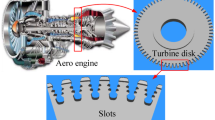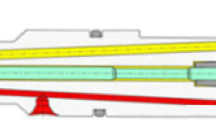Abstract
This study investigates the grinding wheel dressing process in the grinding of aerospace blade root fir tree profile made from Inconel 718 alloy. This work primarily aims to determine the influence of dressing process parameters on the grinding process and the quality of the grinded surface with the use of a profile roller. The grinding of the blade root surface was tested using different settings of the dressing process. Grinding force components and vibration amplitude were recorded, and the grinded surface roughness was measured after each test. The most important finding of the study was the determination of the relationship of dressing speed ratio, dressing feed, the components of the grinding force, and the grinded surface roughness. Based on the identified relationships in the dressing process, the appropriate values of dressing parameters can be selected to obtain the required quality of the grinded surface of the root.
Similar content being viewed by others
References
E. O. Ezugwu, Z. M. Wang and A. R. Machado, The machinability of nickel-based alloys: A review, Journal of Materials Processing Technology, 86 (1999) 1–16.
T. Pei-Lum, Study on the grinding of Inconel 718, Journal of Materials Processing Technology, 55 (1995) 421–426.
E. O. Ezugwu, J. Bonney and Y. Yamane, An overview of the machinability of aeroengine alloys, Journal of Materials Processing Technology, 134 (2) (2003) 233–253.
F. Klocke, S. L. Soo, B. Karpuschewski, J. A. Webster, D. Novovic, A. Elfizy, D. A. Axinte and S. Tönissen, Abrasive machining of advanced aerospace alloys and composites, CIRP Annals-Manufacturing Technology, 64 (2) (2015) 581–604.
S. Malkin and C. Guo, Grinding Technology. Theory and Applications of Machining with Abrasives, Industrial Press, New York, USA (2008).
M. Sedighi and D. Afshari, Creep feed grinding optimization by an integrated GA-NN system, Journal of Intelligent Manufacturing, 21 (6) (2010) 657–663.
I. D. Marinescu, M. Hitchiner, E. Uhlmann, W. B. Rowe and I. Inasaki, Handbook of Machining with Grinding Wheels, CRC Press, Boca Raton, FL (2007).
T. M. A. Maksoud, Heat transfer model for creep-feed grinding, Journal of Materials Processing Technology, 168 (3) (2005) 448–463.
X. P. Xu, Y. Q. Yu and H. J. Xu, Effect of grinding temperatures on the surface integrity of a nickel-based alloy, Journal of Materials Processing Technology, 129 (2002) 359–353.
O. Çolak, Investigation on machining performance of inconel 718 under high pressure cooling conditions, Journal of Mechanical Engineering, 58 (11) (2012) 683–690.
J. Elanchezhian, M. Pradeep Kumar and G. Manimaran, Grinding titanium Ti-6Al-4V alloy with electroplated cubic boron nitride wheel under cryogenic cooling, J. Mech. Sci. Technol., 29 (2015) 4885–4890.
B. Kruszyński and P. Lajmert, An intelligent system for online optimization of the cylindrical traverse grinding operation, Proceedings of the Institution of Mechanical Engineers, Part B: Journal of Engineering Manufacture, 220 (3) (2006) 355–363.
P. V. Vinay and C. Srinivasa Rao, Temperature assessment in surface grinding of tool steels, J. Mech. Sci. Technol., 29 (2015) 4923–4932.
W. B. Rowe, Principles of Modern Grinding Technology, Second Edition, William Andrew, USA (2014).
F. Klocke, J. Thiermann and P. Mattfeld, Influence of the dressing process on grinding wheel wear, Prod. Eng. Res. Devel., 9 (5) (2015) 563–568.
F. Klocke and B. Linke, Mechanisms in the generation of grinding wheel topography by dressing, Prod. Eng. Res. Devel., 2 (2) (2008) 157–163.
X. Cearsolo, I. Cabanes, J. A. Sanchez, I. Pombo and E. Portillo, Dry-dressing for ecological grinding, Journal of Cleaner Production, 135 (2016) 633–643.
C. Zhou, H. Deng, G. Chen, Y. Zhang, D. Wang and X. Zhou, Numerical simulation of single-pulse laser ablation for dressing a bronze-bond diamond grinding, Precision Engineering, 43 (2016) 78–85.
J. Pfaff, M. Warhanek, S. Huber, T. Komischke, F. Hänni and K. Wegener, Laser touch dressing of electroplated CBN grinding tools, Procedia CIRP, 46 (2016) 272–275.
B. Linke and F. Klocke, Temperatures and wear mechanisms in dressing of vitrified bonded grinding wheels, International Journal of Machine Tools and Manufacture, 50 (2010) 552–558.
H. Kitzig, T. Tawakoli and B. Azarhoushang, A novel ultrasonic-assisted dressing method of electroplated grinding wheels via stationary diamond dresser, The International Journal of Advanced Manufacturing Technology, 86 (2016) 487–494.
B. Denkena, J. Köhler and S. Woiwode, Dressing of vitrified bonded CBN tools for continuous generating grinding, Prod. Eng. Res. Devel, 8 (5) (2014) 585–591.
E. Uhlmann and L. Hochschild, Tool optimization for high speed grinding, Prod. Eng. Res. Devel., 7 (2) (2013) 185–193.
M. Islam et al., Convex diamond patterns by grinding with a wheel which is dressed by a rounded tool, J. Mech. Sci. Technol., 30 (2016) 1865–1873.
A. Daneshi, N. Jandaghi and T. Tawakoli, Effect of dressing on internal cylindrical grinding, Procedia CIRP, 14 (2014) 37–41.
Author information
Authors and Affiliations
Corresponding author
Additional information
Recommended by Editor Haedo Jeong
Żyłka Ł. completed his Ph.D. in Mechanical Engineering with a focus on the diagnostics of gear grinding process. Currently, he is an Assistant Professor in the Department of Manufacturing Techniques and Automation at Rzeszow University of Technology, Poland. He has 15 years of experience in teaching and research. His research interests include creep feed grinding and high-pressure cooling in grinding processes.
Babiarz R. completed his Ph.D. in Mechanical Engineering with a focus on the regulation of the cylindrical grinding process using RMS of acoustic emission signal. He is an Assistant Professor in the Department of Manufacturing Techniques and Automation at Rzeszow University of Technology, Poland. His main scientific interest involves the diagnostic and adaptive regulation of aerospace materials during machining. At present, he is conducting an experimental research on grinding difficult-to-machine materials.
Rights and permissions
About this article
Cite this article
Żyłka, Ł., Babiarz, R. Dressing process in the grinding of aerospace blade root. J Mech Sci Technol 31, 4411–4417 (2017). https://doi.org/10.1007/s12206-017-0841-6
Received:
Revised:
Accepted:
Published:
Issue Date:
DOI: https://doi.org/10.1007/s12206-017-0841-6




